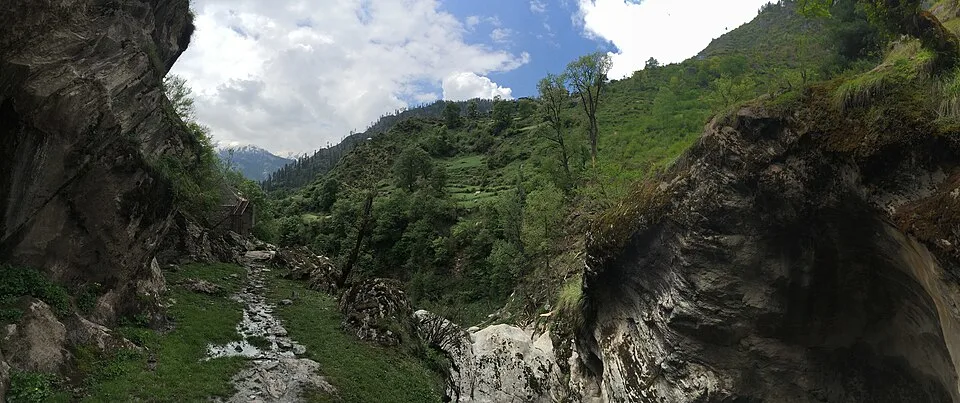Himachal Pradesh, cradled in the mighty Himalayas, is a trekker’s paradise, offering trails that weave through snow-draped peaks, verdant valleys, and serene alpine lakes. Each trek is a unique adventure, blending natural splendor with cultural richness. Below is a detailed exploration of the top 10 trekking destinations in Himachal Pradesh, complete with specifics on routes, challenges, and highlights, tailored for adventurers of all levels.
1. Hampta Pass Trek
Overview: The Hampta Pass Trek is renowned for its dramatic transition from the lush Kullu Valley to the stark, arid landscapes of Lahaul. At 14,010 feet, the pass offers breathtaking views of peaks like Deo Tibba and Indrasan.
Details:
- Starting Point: Jobra, near Manali.
- Distance and Duration: Approximately 26 km, 4-5 days.
- Difficulty: Moderate, suitable for beginners with some fitness.
- Route: The trek begins in Jobra, passing through pine forests and meadows to Chika, then ascends to Balu ka Ghera, a sandy stretch. The climb to Hampta Pass is steep, followed by a descent to Shea Goru and Chatru in Lahaul.
- Highlights: The contrast between Kullu’s greenery and Lahaul’s barrenness, glacial streams, and the vibrant Chhika campsite.
- Best Time: June to October, with clear weather and accessible trails.
- Tips: Carry warm clothing for the pass, as temperatures can drop significantly. Acclimatization in Manali is recommended.
2. Beas Kund Trek
Overview: Beas Kund, the source of the Beas River, is a beginner-friendly trek near Manali, leading to a glacial lake at 12,139 feet, surrounded by peaks like Hanuman Tibba.
Details:
- Starting Point: Dhundi, 21 km from Manali.
- Distance and Duration: 15-17 km round trip, 2-3 days.
- Difficulty: Easy to moderate, ideal for novices.
- Route: From Dhundi, the trail winds through Solang Valley, crossing meadows and streams to reach the serene Beas Kund. Return via the same route or extend to Bakarthach meadow.
- Highlights: Crystal-clear lake, panoramic mountain views, and wildflower-strewn meadows in summer.
- Best Time: May to October, with vibrant landscapes in June and September.
- Tips: Carry light rain gear for sudden showers. Local guides enhance the experience with insights into the region’s ecology.
Image Credits- Ultimate Guide to Kugti Pass Trek 2025: Day-Wise Itinerary, Tips & Highlights
3. Triund Trek
Overview: A short, scenic trek from McLeod Ganj, Triund offers stunning views of the Dhauladhar Range at 9,432 feet, perfect for a weekend getaway.
Details:
- Starting Point: McLeod Ganj, Dharamshala.
- Distance and Duration: 9 km one way, 1-2 days.
- Difficulty: Easy, suitable for beginners.
- Route: The trail passes through oak and rhododendron forests, with stops at Galu Devi Temple and Magic View Café, leading to the open meadow at Triund.
- Highlights: 360-degree views of Kangra Valley, sunset at Triund, and stargazing while camping.
- Best Time: March to June and September to December; avoid heavy monsoon months.
- Tips: Book campsites in advance during peak seasons. Carry sufficient water, as sources are limited on the trail.
4. Kheerganga Trek
Overview: In Parvati Valley, Kheerganga is famous for its hot springs and spiritual vibe, offering a moderate trek with stunning river views.
Details:
- Starting Point: Barshaini, near Kasol.
- Distance and Duration: 12 km one way, 2-3 days.
- Difficulty: Moderate, suitable for fit beginners.
- Route: The trail follows the Parvati River through Nakthan and Rudranag villages, ascending through pine forests to Kheerganga’s meadow and hot springs.
- Highlights: Soaking in natural hot springs, views of Parvati Valley, and the Rudranag waterfall.
- Best Time: April to June and September to November for pleasant weather.
- Tips: Respect local customs at the hot springs. Carry a lightweight tent for camping flexibility.
5. Pin Parvati Pass Trek
Overview: A challenging trek connecting Parvati Valley to Spiti’s Pin Valley, this high-altitude pass at 17,457 feet is for seasoned trekkers.
Details:
- Starting Point: Barshaini, Kullu.
- Distance and Duration: 78 km, 7-10 days.
- Difficulty: Difficult, requiring prior high-altitude experience.
- Route: The trail crosses Kheerganga, Mantalai Lake, and the Pin Parvati Pass, descending to Pin Valley via Tunda Bhuj and Mudh. It involves glacier crossings and moraine fields.
- Highlights: Sacred Mantalai Lake, Spiti’s barren landscapes, and diverse flora and fauna.
- Best Time: July to September, though weather can be unpredictable.
- Tips: Hire experienced guides and porters. Carry high-calorie food and altitude sickness medication.
Image Credits- Beautiful Lakes in India To Take Your Breath Away
6. Bhrigu Lake Trek
Overview: Near Manali, this trek leads to the sacred Bhrigu Lake at 14,100 feet, offering spectacular meadow and mountain views.
Details:
- Starting Point: Gulaba, near Manali.
- Distance and Duration: 25 km, 3-4 days.
- Difficulty: Moderate, suitable for fit beginners.
- Route: The trail ascends through orchards and forests to Rola Kholi, then to Bhrigu Lake via alpine meadows. Return via Vashisht.
- Highlights: Vibrant meadows in monsoon, reflections in the lake, and views of Pir Panjal peaks.
- Best Time: May to October; July-August for blooming meadows.
- Tips: Start early to avoid afternoon clouds. Carry sunscreen for high-altitude sun exposure.

7. Chandratal Lake Trek
Overview: Known as the “Moon Lake,” Chandratal in Spiti Valley is a high-altitude gem at 14,100 feet, offering surreal beauty.
Details:
- Starting Point: Batal or Kunzum Pass.
- Distance and Duration: 30 km round trip, 2-3 days.
- Difficulty: Moderate, due to high altitude.
- Route: From Batal, the trail crosses rugged terrain to the crescent-shaped lake, with camping near its shores. Return via the same route.
- Highlights: Crystal-clear lake, stark Spiti landscapes, and starry nights.
- Best Time: June to September, when roads are open.
- Tips: Acclimatize in Spiti to avoid altitude sickness. Carry warm layers for cold nights.
8. Indrahar Pass Trek
Overview: A challenging trek in the Dhauladhar Range, Indrahar Pass at 14,245 feet offers dramatic views for experienced trekkers.
Details:
- Starting Point: McLeod Ganj.
- Distance and Duration: 35 km, 4-5 days.
- Difficulty: Difficult, due to steep climbs and weather.
- Route: The trail passes Triund, Laka Glacier, and Lahesh Cave before the steep ascent to Indrahar Pass, descending to Chamba.
- Highlights: Laka Glacier, Pir Panjal views, and the rugged pass.
- Best Time: May to June and September to October.
- Tips: Use trekking poles for steep sections. Check weather forecasts before starting.
Explore More- Majestic Palaces in India That Embody Royal Grandeur
9. Sar Pass Trek
Overview: A classic trek in Parvati Valley, Sar Pass at 13,799 feet is known for its snow slides and scenic beauty.
Details:
- Starting Point: Kasol.
- Distance and Duration: 48 km, 5-6 days.
- Difficulty: Moderate, suitable for beginners with stamina.
- Route: The trail goes through Grahan village, Min Thach, and Nagaru to Sar Pass, descending via Biskeri Thach to Barshaini.
- Highlights: Snow slides from the pass, frozen Sar Lake, and Parvati Valley views.
- Best Time: May to June and September to October.
- Tips: Wear sturdy shoes for snow sections. Join organized groups for safety.
10. Prashar Lake Trek
Overview: A serene weekend trek in Mandi, leading to Prashar Lake at 8,960 feet, known for its floating island and temple.
Details:
- Starting Point: Baggi village, Mandi.
- Distance and Duration: 7.5 km one way, 1-2 days.
- Difficulty: Easy to moderate, great for families.
- Route: The trail climbs through forests to the lake, with views of Dhauladhar peaks. Return via the same path.
- Highlights: Mystical lake, Prashar Rishi Temple, and tranquil meadows.
- Best Time: March to June and September to December.
- Tips: Carry a camera for the lake’s beauty. Respect the temple’s sanctity.
General Trekking Tips for Himachal Pradesh
- Physical Preparation: Train with cardio and strength exercises 4-6 weeks prior, especially for high-altitude treks like Pin Parvati or Indrahar Pass.
- Acclimatization: Spend 1-2 days at the trek’s base (e.g., Manali, Kasol) to adjust to altitude, reducing the risk of altitude sickness.
- Guides and Permits: Hire local guides for challenging treks and obtain necessary permits (e.g., for Spiti treks) from local authorities.
- Weather Awareness: Check forecasts, as Himalayan weather can change rapidly. Avoid trekking during heavy monsoons (July-August) for most trails.
- Eco-Conscious Trekking: Follow the “leave no trace” principle. Avoid littering, especially at pristine sites like Chandratal and Bhrigu Lake.
- Hydration and Nutrition: Drink at least 3-4 liters of water daily. Carry high-energy snacks like nuts, dried fruits, and energy bars.
- Group Trekking: For safety, trek in groups or with organized tours, especially for remote treks like Pin Parvati Pass.
- Emergency Preparedness: Carry a basic first-aid kit, emergency contact numbers, and a satellite phone for remote areas with no network.
What to Pack for Trekking in Himachal Pradesh
- Clothing:
- Moisture-wicking base layers (2-3 sets).
- Insulating fleece or wool mid-layers.
- Waterproof and windproof jacket (Gore-Tex recommended).
- Trekking pants (quick-dry, 2 pairs).
- Warm hat, gloves, and socks (wool or synthetic, 3-4 pairs).
- Sturdy, waterproof trekking boots with good grip.
- Gear:
- Backpack (40-60 liters, with rain cover).
- Trekking poles (especially for steep treks like Indrahar).
- Lightweight tent and sleeping bag (rated for 0°C or lower for high-altitude treks).
- Sleeping pad for insulation.
- Essentials:
- Water bottle or hydration pack (2-3 liters capacity).
- Water purification tablets or portable filter.
- High SPF sunscreen, lip balm, and sunglasses (UV protection).
- Headlamp with extra batteries.
- Multi-tool or knife.
- Food and Cooking:
- High-calorie snacks (nuts, chocolate, energy bars).
- Lightweight stove and fuel (for longer treks).
- Reusable mess kit (plate, cup, spork).
- Health and Safety:
- First-aid kit (bandages, antiseptic, painkillers, altitude sickness medication like Diamox).
- Personal medications and insect repellent.
- Emergency blanket and whistle.
- Miscellaneous:
- Lightweight camera or smartphone for photography.
- Map, compass, or GPS device (offline maps for remote areas).
- Biodegradable soap and small towel.
- Identification and permits.
Conclusion
Himachal Pradesh’s trekking trails offer unparalleled adventure, from serene lakes to challenging high-altitude passes. Each trek provides a unique glimpse into the Himalayas’ diverse ecosystems and cultural heritage. Prepare with proper gear, respect local guidelines, and choose the right season for a safe and memorable journey. Whether you’re a novice or a seasoned trekker, Himachal’s trails promise awe-inspiring experiences.
Image Credits- Kheerganga Trek

